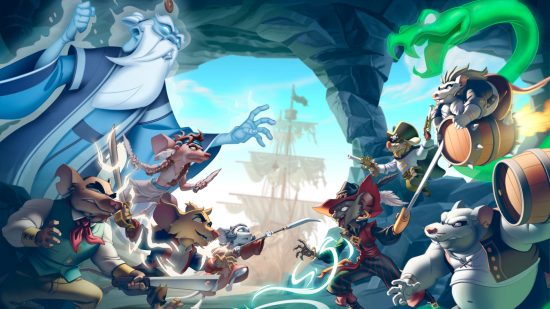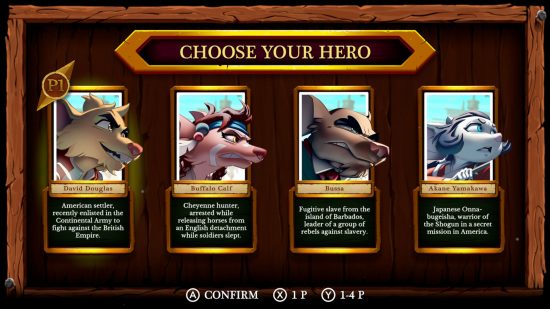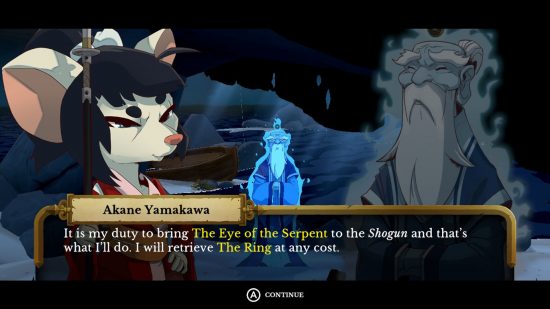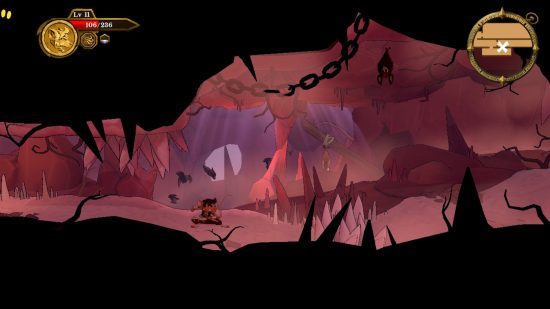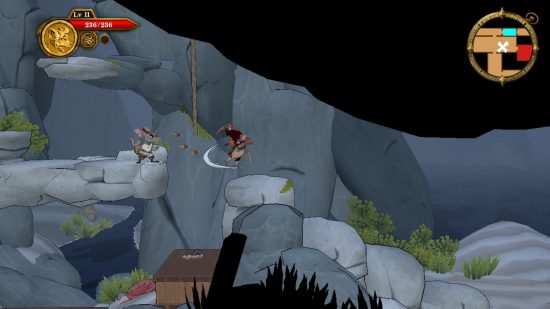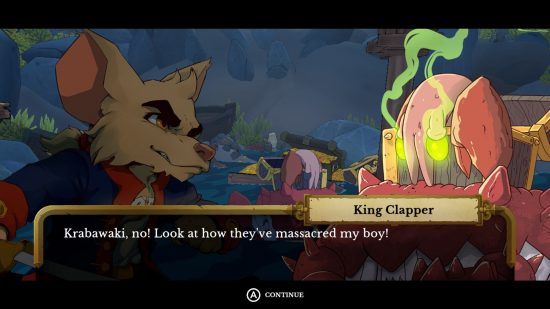Our Verdict
Curse of the Sea Rats is a truly beautiful Metroidvania-like, with stunning, hand-drawn characters, a charming story, and an intriguing world. Unfortunately, its sluggish controls and input delay hold it back, making this swash-buckling bonanza feel more punishing than it needs to be.
Curse of the Sea Rats is a very difficult game for me to review, to be honest. As soon as I saw the trailer, I instantly fell in love with the art style, and I attest to that after spending many hours in-game. The hand drawn, 2D animations are lovely, the characters are so full of life and emotion, and the world they inhabit is full of detail, unique environments, and fun secrets to uncover.
On the other hand, the gameplay itself leaves me feeling very divided. Curse of the Sea Rats calls itself a ‘ratroidvania’, and it certainly does maintain many of the core gameplay characteristics that define a Metroidvania-like title. Unfortunately, it also lacks some of the most important features that make other Metroidvania games work.
But I’m getting ahead of myself – let’s start at the beginning, shall we? Curse of the Sea Rats is a side-scrolling, 2D platformer with a heavy focus on combat. The story begins with a Royal Navy flagship transporting a horde of evil pirates and prisoners awaiting judgement. However, during its voyage from the Caribbean back to Great Britain, a tumultuous storm forces the journey to take quite an unexpected turn, with pirate Flora Burn taking this to her full advantage.
Through the power of the Curse of the Serpent amulet, Flora Burn turns everyone aboard the ship into rats, and the ship washes up on the shore of an island. She then kidnaps the Admiral’s son and escapes with her crew. In desperation, Admiral Benjamin Blacksmith turns to a group of four criminals, bargaining that, if they manage to capture Flora Burn – dead or alive – and return his son to safety, he will grant them their freedom. And thus, your seafaring journey begins.
You can choose from one of four rats, each with their own unique skillset, strengths, and weaknesses. You can later switch between the playable rats at different checkpoints, so it’s worth trying them all out to see which one suits your personal playstyle. The game also offers up to four-player co-op, which you can activate from these same checkpoints.
Each of the rats has a series of normal attacks, one magical skill, and two skill trees for you to upgrade – one that improves your normal attacks and another that improves your magical powers. In order to purchase these upgrades, you need to spend the souls that you earn from felling your foes.
All of the rats level up in unison, so, for example, if you choose to play as David Dougless but later decide you want to try Akane Yamakawa, Akane starts at the same level that you got David to, even if you haven’t tried her before. However, their skill trees are unique, and you share souls with your co-op partners, so it’s important to coordinate with your allies and be mindful before purchasing a skill upgrade.
Co-op partners also share the same pool of money and items, including the limited amount of healing items you can carry, so it’s very important to work together and decide as a team when it comes to consuming or purchasing something.
I really enjoy the brief backstories, designs, and feel of each character, though some certainly have a substantial advantage over others in combat. For example, Buffalo Calf is the only character with reliable ranged damage and, considering that it’s very easy to take damage if you get too close to enemies, this is a massive advantage over the rest of the playable characters – to the point that it massively outweighs her lower HP.
Curse of the Sea Rats has a Metroidvania-style, non-linear map. While the opening section only has a few branches, as you progress you find a lot of different routes to explore, and there are a lot of areas you need to return to later after finding specific items or unlocking new skills.
This backtracking doesn’t feel too tedious as each area is quite small and has its own unique environmental aesthetic, which keeps exploration feeling fresh. Plus, you can also use souls to unlock teleporters at certain points, or you can pick up single-use return bell items, which instantly port you back to the shop near the shipwreck.
There are a few elements, such as dangerous spikes, which I feel could be highlighted with more clarity, as they occasionally blend in with the background. But this is quite a small niggle that you get used to quite quickly.
However, one thing that does add to the sense of tedium is the quick respawn times for enemies. As soon as you leave an area, the enemies respawn when you next return. This was actually beneficial to me when I found myself needing to grind in early game solo play, but it does feel a bit tiresome when you’re consistently doubling back on yourself to explore different branches and secret areas and end up fighting the same three enemies multiple times.
This actually leads me nicely to the biggest issue with this game – the combat and difficulty levels. Combat in Curse of the Sea Rats is pretty challenging, moreso in the early game, which isn’t necessarily a bad thing. Your skillset is quite small, consisting predominantly of a basic attack, a jump, a parry, a slide, and a simple magic skill, until you unlock a few skill variations later. You can also switch up your normal attack by using additional inputs to perform an uppercut, a jump attack, a downward attack, etc.
Your health pool is quite small, especially to start off with, and the enemies hit hard. There’s a surprisingly steep difficulty slope right at the beginning of the game, where you meet the first boss Fatso within about ten to 20 minutes of gameplay – in fact, you could even unsuspectingly stumble across him with your character still at level one. He’s a bit of a shock to the system, to be honest, as his moves are very fast, deal quite a lot of damage, and rely on you reading his animations and jumping over him with great precision, which quickly highlights some of the main flaws with the combat system. The difficulty does level out later, but it honestly may be too late for many players dipping their toes in.
Above all, this game falls short due to its input delay and unresponsive commands. For the most part, moves feel quite slow and sluggish, which I feel is likely due to the beautifully hand-drawn animation frames. There are no animation cancels, the parry (which also acts as your only real block) is both slow and has a very small window of efficacy, and most attacks appear to root you in place, often leaving you vulnerable to enemy attacks.
Your slide dash is a very important move, and you really need to master it in order to take down the second major boss (and future enemies, too). You perform it by pulling your joystick down and hitting X simultaneously, the latter of which also happens to be the jump button. However, I found that, on both the Joy-Cons and an official Switch Pro Controller, if you don’t pull the joystick perfectly down and centred, it doesn’t work. So, if your joystick is at five or seven on a clock face rather than six, you jump instead – the exact opposite of what you want to do, which can often end up fatal.
Additionally, switching from side to side is slow and unresponsive, which is a fatal flaw in this type of game. And if you decide to try the D-pad instead of the joystick and flick to left and right too quickly, it stops reading your inputs, sometimes leaving your character running in the opposite direction of the one you’re pressing.
I will say that the game becomes significantly more manageable with a co-op partner. I had a major Metroidvania fan join me for my second playthrough, and the fact that you can resurrect each other without respawning back at the checkpoint, along with the way your skills seem to synergise with each other, makes the game feel far easier. As such, it really feels like Curse of the Sea Rats has always had co-op in mind over single-player experience. But, even then, my co-op partner found himself very frustrated by the unresponsive inputs, especially when compared to the snappiness he’s come to expect from other Metroidvania-like titles.
I know I sound very harsh here, and believe me, I both really want to like this game and certainly see the positives in it, but these issues genuinely leave me questioning who this game is for. Its vibrant, 2D animated artstyle, fairy-tale-like setting, and focus on drop-in, drop-out co-op makes it look like the perfect family game, but its steep difficulty curve in the early game is enough to put younger or casual players off by the time they reach the first boss. On the other hand, while the gameplay and difficulty may appeal to fans of Metroidvania-like games, the sluggish inputs and unresponsive skills and combos will likely leave many hardcore gamers unsatisfied.
While there’s still plenty to enjoy here, and some of you may be able to overlook these issues, I feel that the best thing Petoons could do with Curse of the Sea Rats is to either introduce difficulty settings to make it more accessible to a wider range of demographics, or to patch up the input delay and introduce animation cancels, otherwise it truly does feel like it will alienate many players.
Of course, I have been playing the game prior to release, and PQube has provided me with a list of features covered in the day one patch, with ‘adjustments to enemy and character balance’ included in the checklist. As such, I hope this will make it a little less punishing for more casual players, but until the patch is here I can’t really comment on whether Petoons has addressed any of these issues.
Beyond controls, the overall performance of the game is pretty great. Of course, with the animations being hand-drawn, they don’t have a particularly high number of frames, but they look pretty smooth, and everything generally fits well with the overall aesthetic of the game. I did experience some frame rate drops in co-op, but this is another issue supposedly addressed in the day one patch, so I have hope that this will be less noticeable on launch.
I genuinely enjoy the sound design of Curse of the Sea Rats. There are some real, swashbuckling bangers in the OST, and they switch up depending on the environment or what boss you’re fighting. There’s also some great voice acting with a massive range of accents from all around the world, which is truly a delight.
So, to gather all my thoughts, Curse of the Sea Rats is okay. It delivers on the front of gorgeous art, an intriguing narrative, and a fun map to explore, and I think the retail price is reasonable if you can overlook some of the game’s shortcomings.
On the other hand, its sluggish controls and input delays make the difficulty feel far more punishing than rewarding, and there were quite a few occasions where both my hardcore Metroidvania fan co-op partner and I nearly walked away and didn’t come back – not due to us hitting an impassable wall or boss, but rather because we found ourselves frustrated at a cheap exploding chicken or a hidden spike trap.
You can certainly feel the love that the artists and devs poured into Curse of the Sea Rats, and with some minor changes, this could easily be a cult classic one day. But, as much as it pains me to say this, I simply don’t find this game fun in its current state – though that doesn’t mean that you won’t. Just don’t board this ship thinking it will be a treasure trove of family-friendly fun, nor a perfect Metroidvania, Cuphead-style game.
Phew, that was a tough one! If you fancy a different type of challenge, head on over to our list of the best Switch survival games. Or, for something a little more beginner friendly, check out our top picks for the best Switch games for kids.
